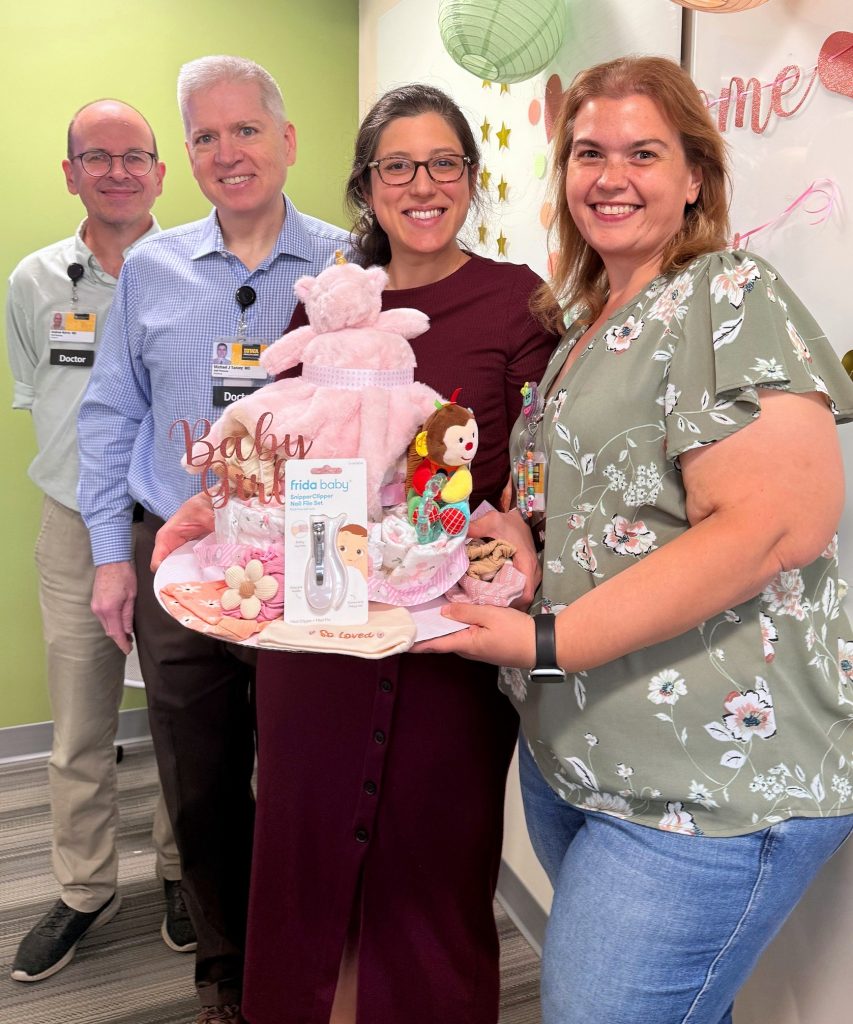Today we had a quick lunch time gathering to fête Dr. A, who is expecting.


Lifestyle interventions can be a very powerful means to impact adolescent obesity. However lifestyle counseling of adolescence is notoriously difficult. Physicians are often poorly trained to meet this challenge. These discussions are fraught with some risk that insensitive approaches might trigger disordered eating and/or disturbed body image. To help physicians address these challenges, Dr. Lauren Kanner from our division is part of a team delivering a lecture entitled “Neither Feast nor Famine: Weight-Inclusive Approaches to Counseling Youth with Higher BMIs”. This lecture aims to provide physicians with strategies to effectively counsel adolescents to enact positive lifestyle changes. The lecture will be delivered by Dr. Kanner in conjunction with Dr. Maya Kumar from Rady Children’s Hospital. The lecture is co-sponsored by Society for Adolescent Health and Medicine (SAHM) and the North American Society for Pediatric & Adolescent Gynecology (NASPAG). The webinar will occur on October 8, 2025. See this link to sign up to view the webinar.

On September 19th, Dr. Ramakrishna from our division co-presented Pediatric Grand Rounds along with pediatric psychologist Dr. Laura Fuller. Their talk, entitled “Treating Patients with Differences of Sexual Development: The Intersection of Medicine and Psychology”, explored the complexities of the medical and psychological healthcare of Differences of Sexual Development (DSD).
DSDs encompass a group of conditions in which the typical processes of sexual development—anatomical, hormonal, functional, and reproductive—do not follow the usual male or female patterns. These variations may be apparent at birth or even prenatally, though some forms may not be diagnosed until adolescence or adulthood.
The primary goal of pediatric DSD care is to support the physical and emotional well-being of affected individuals during youth. During their presentation, Drs. Ramakrishna and Fuller provided an overview of the various types of DSDs and illustrated the unique medical and psychosocial needs of patients through case examples. They emphasized the importance of a multidisciplinary approach to care.
Drs. Ramakrishna and Fuller lead a multidisplinary DSD clinic that includes pediatric endocrinologists, pediatric urologists, clinical geneticists, and pediatric radiologists, with support from reproductive endocrinology and clinical pharmacy services.
We extend our sincere thanks to Drs. Ramakrishna and Fuller for their insightful presentation and for their leadership in delivering expert, compassionate DSD care through their multidisciplinary team.

On September 23, Dr. Alexandrou from our division will be helping present psychiatry grand rounds on the topic of “mental health care/screening in Turner’s syndrome“. Dr. Alexandrou will have a co-speaker on the topic, Dr. Erin Olufs, who is a child psychologist. They will be speaking about the importance of screening for mental health issues in youth and young adults with Turner syndrome. Research has shown that women with Turner syndrome have increased risk of a variety of mental health concerns, including anxiety, depression, and autism spectrum disorders among others. Screening for these conditions is important and early and skilled intervention can be helpful. We are grateful that Drs. Alexandrou and Olufs will be able to share their expertise and experience in this important area of health care.

In 2017, Gary D. Hughes established a philanthropic gift dedicated to finding a cure for type 1 diabetes and improving the lives of children with this disease. The gift has established the Gary D. Hughes Professorship in Pediatric Endocrinology, which is held by Michael Tansey, MD. Dr. Tansey is an ideal recipient for the Professorship, as he has devoted his career to the advancement of type 1 diabetes care and treatment. Having published over 60 manuscripts, primarily focused on type 1 diabetes, Dr. Tansey has contributed to knowledge about continuous glucose monitors, insulin pumps, and emerging treatments that can forestall the onset of type 1 diabetes. Today, the University honored Dr. Tansey and Gary D. Hughes for this partnership that has and will continue to benefit children with diabetes.


We’re pleased to share that Dr. Kanner from our division was recently featured in a YouTube podcast hosted by pediatrician and author Dr. Carole Keim. In their 40-minute conversation, Dr. Kanner provides expert insights into a range of endocrine conditions that can affect infants and young children.
The discussion begins with congenital hypothyroidism, a serious but treatable condition that can be identified through routine newborn screening. Dr. Kanner then explores disorders related to growth abnormalities, including both insufficient and excessive growth patterns.
The conversation also covers the various forms of pediatric diabetes, highlighting key symptoms that caregivers should watch for. The episode concludes with practical advice on promoting healthy nutrition and physical activity habits in children to support long-term endocrine health.
We invite you to watch this informative and accessible interview here: the podcast on YouTube.
Thank you, Dr. Kanner, for sharing your expertise and helping to raise awareness about these important pediatric health issues.

We are pleased to announce that Dr. Benjamin Palmer is starting as a new pediatric endocrinologist in our division. He received his Medical Doctorate from the University of Iowa Carver College of Medicine, completed pediatric residency at the University of Iowa Stead Family Children’s Hospital, where he also just completed fellowship in pediatric endocrinology. He has published expertise in several aspects of diabetes care in youth. His ongoing clinical interests revolve around diabetes, including diabetes and sports/exercise, and the rapidly advancing field of diabetes technology. In clinic, his initial practice will include general pediatric endocrinology and diabetes, as well as outreach services in Cedar Rapids and Dubuque. Welcome Dr. Palmer!

Cystic fibrosis often disrupts gastrointestinal function, impairing the absorption of fat-soluble vitamins such as vitamin D. As a result, individuals with cystic fibrosis are at increased risk for vitamin D deficiency. While daily supplementation is a common corrective strategy, it adds to the already significant treatment burden faced by these patients.
An alternative approach known as stoss dosing involves administering a single, very high dose of vitamin D. This method is effective because vitamin D remains active in the body for several weeks, potentially reducing the need for daily supplementation.
To evaluate the effectiveness of stoss dosing, researchers analyzed the medical records of 58 individuals with cystic fibrosis who received this treatment. Their findings showed that vitamin D levels were increased by the therapy, as measured three months after the dose administration. However, only about half of the patients reached the target vitamin D levels, suggesting that while stoss dosing is likely beneficial, further research and optimization are necessary.
Dr. Larson Ode from our division contributed to the research, which has been peer-reviewed, published in Health Science Report and is publicly available in the PubMed Central repository (link).

We are excited to announce that Dr. Alexandrou has been selected to serve as Co-Director of the Flocks Learning Community at the University of Iowa’s Carver College of Medicine. Each medical student at the Carver College of Medicine is matched into one of four Learning Communities. These Learning Communities enhance the activities and learning environment of students, in part by providing a physical study space. In her role as Co-Director, Dr. Alexandrou will provide leadership for the students in the Flocks community. She will support their support educational, philanthropic, and social endeavors in a way that extends beyond the formal medical school curriculum. Furthermore, she will provide guidance to ease transition to the rigors of medical school and give career mentorship. This is a part-time activity and Dr. Alexandrou will continue her important role as a clinical doctor providing care to children and youth with hormonal and endocrine disorders. We envision that she will provide astute and caring guidance to the Flocks Learning Community.
Diabetes Nurse Kaitelynn has been nominated for a Daisy Award, not once but twice this summer! The Daisy Award recognizes nurses who exemplify skillful and compassionate care to patients and their families. She is pictured below being presented with one of her Daisy pins and letters. We’ve notice that she already has several Daisy pins on her badge, evidence that she is so great with patients and their families. Thanks Kaitelynn for being one of our group of amazing pediatric diabetes nurses!!